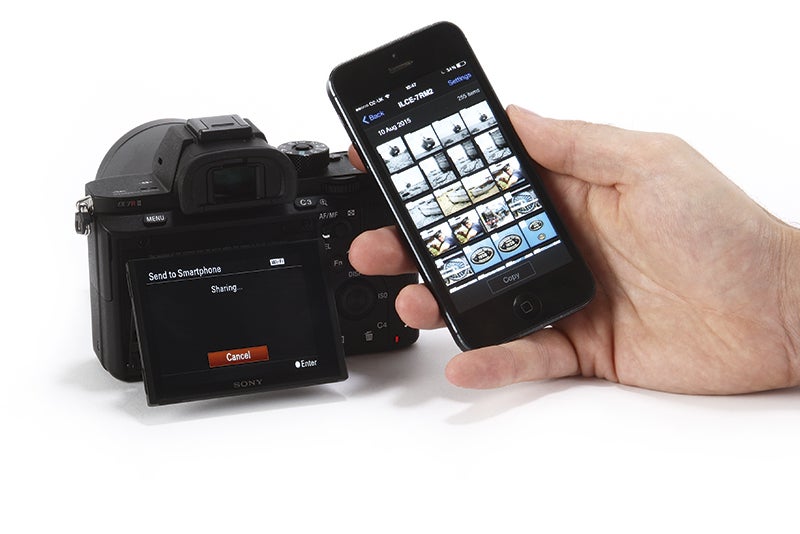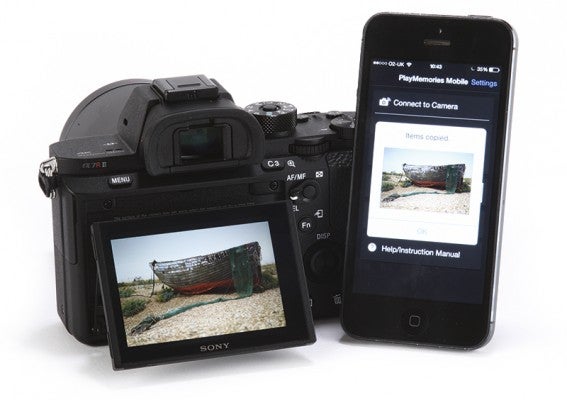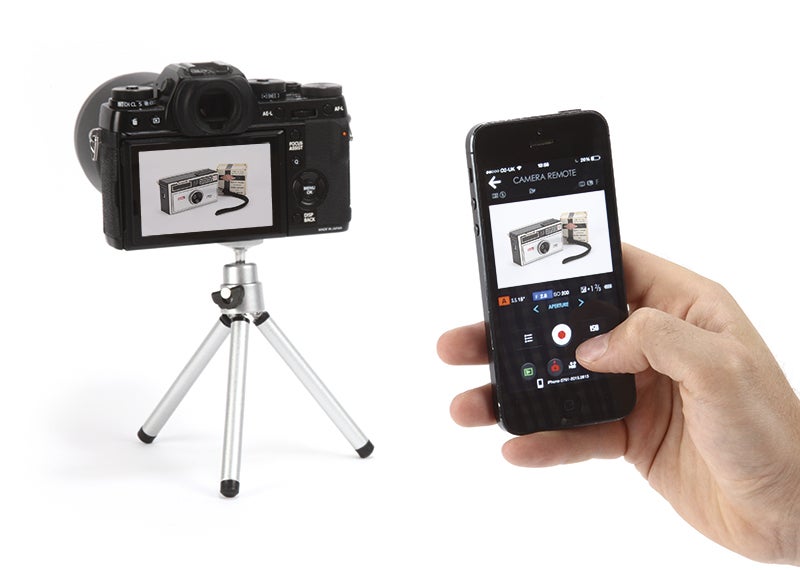Many cameras now come with built-in Wi-fi connectivity that allows you to connect them to a smartphone or tablet with the help of a first-party app.
In the past few years, built-in Wi-fi connectivity has gone from being something of a luxury to a much more standard feature that’s now included with most new digital cameras. Wi-fi connectivity in cameras allows your camera to talk to your smartphone or tablet, which allows you to combine your camera’s superior image-gathering capabilities with your mobile device’s processing power, onboard storage and internet-ready capabilities. Of course, photographers will always need to upload their images to a desktop computer for editing, but out in the fi eld, the ability to connect your camera to a smartphone or tablet offers a range of benefits. For example, you can back up your images to your mobile device without having to remove any memory cards or fiddle around with card readers and portable hard drives.
So long as you’re in range of a public Wi-fi hotspot or a 3G/4G mobile data signal, you’ll also be able to use your connected mobile device to email images or upload them to popular social media sites almost as soon as they’ve been taken. Last but not least, many apps also allow you to control your camera remotely, which can be useful in a range of situations – from self-portraits to capturing shy wildlife from a safe distance.
In order to make all of this possible, you’ll need to download and install one of the first-party apps offered by the various manufacturers. These are free on the Apple App Store and Google Play, and essentially act as the interface between your camera and your phone or tablet.
Of course, not all apps are created equal, and some are easier to set up and use than others. In addition, some also have greater functionality. We’ve called in a range of Wi-fi enabled cameras from all the major manufacturers with the intention of using them to test and compare the various first-party mobile connectivity apps. Over the next few pages we’ll take a closer look at what’s on offer from each and compare how richly featured, reliable and easy-to-use they are.
See our round up of the best camera apps
Getting started with wi-fi camera apps
When connecting your mobile device to your camera for the first time, you’ll sometimes be asked to input a Wi-fi password, which is usually displayed on your camera at the point of connection. This is to prevent accidental or malicious connections from devices that are not your own. Surprisingly, not all cameras and apps take this approach, with a handful only offering unsecured connections. Once connected, most apps will typically offer three key functions: the ability to wirelessly transfer images from your camera to your smartphone/tablet; the ability to control your camera remotely; and the ability to add location data to your images using your mobile device’s built-in GPS module.
Wireless image transfer
The ability to back images up to your tablet as soon you shoot them is a useful feature. Most apps allow you to transfer images at their original file size, or reduce it for easier uploading. Raw images can usually be transferred, too – even if your mobile device is unable to display such files.
Remote control
One of the most useful things you can do with apps is to use your mobile device to control the camera. Better apps will allow you to control shutter speed, aperture etc from within the app itself, while others offer no more than a remote shutter button.
Do bear in mind that a camera’s Wi-fi range will only extend so far before the signal becomes too weak for your device to pick up. This distance varies depending on your camera along with the strength of your mobile device’s antenna – it’s not something the apps themselves have any control over.
Location tagging
While some cameras have GPS modules built into them, many do not, which is where your mobile might be able to help. You’ll need to enable your location services function on your device before you can use the feature. One important thing to bear in mind is that if you tag an image in a different location from where it was originally shot, then it will be tagged with the GPS data from your new location.
Nikon
Nikon offers a single wi-fi camer app called Wireless Mobile Utility (WMU), which is compatible with all Nikon’s Wi-fi enabled cameras.
The app itself is not password protected by default, so making your first connection is as easy as switching on your camera’s Wi-fi and then selecting it in your device’s Wi-fi menu. Once connected, open up the WMU app and head straight for the options menu that’s located in the top-right corner of the app’s welcome screen. From here, you can rename your camera’s SSID to something more user-friendly and set up a WPA2 password to keep any unwanted connections at bay.
Canon
Canon currently offers three wi-fi camera apps. Canon Camera Window is for older PowerShot and IXUS compacts, and EOS Remote was designed for Canon’s first generation of Wi-fi – enabled DSLRs. Camera Connect, meanwhile, is designed as a one-size-fits-all replacement for the previous two apps and is compatible with virtually all Canon’s Wi-fi enabled cameras.
Use Camera Connect to browse images stored on your camera’s memory card and download them direct to your phone/tablet. You can transfer images at their original size or choose to reduce the overall file size. GPS tagging of images via your smartphone is part-supported, though only when the app is used with certain IXUS and PowerShot models – the feature cannot be used with Canon DSLRs or CSCs.
Camera Connect can also control your camera remotely, with separate aperture and shutter speed controls available alongside exposure compensation and ISO dials. For those using certain Canon compacts with fixed zooms, Camera Connect can also be used to control the zoom.
Fujifilm
Fujifilm offers three apps: Camera Application, Camera Remote and Photo Receiver. Which of the three apps is right for you will depend on which Fujifilm camera you own. Camera Remote is more advanced than the other two and is the only app that allows you to control your camera remotely. Unfortunately, it’s only compatible with the X-T10, X-E2, X-T1, X100T, X30, S1 and F1000EXR. If you don’t own one of these models, you’ll need to use the less advanced Camera Application app. While this lacks remote control, it does offer image transfer and GPS tagging. Photo Receiver, meanwhile, is the most basic of the three and has no GPS function. It does work with most Fujifilm cameras though.
Pentax
Pentax only offers one app, but it’s a good one. Image Sync allows you to control your camera remotely, with a generous range of controls including shutter speed, aperture, white balance, exposure compensation and ISO. User settings can be quickly overridden by pressing the green button in the bottom right-hand-corner, which effectively puts the camera into fully automatic mode. Unfortunately, there’s no way to record video remotely, though. Images can be wirelessly transferred from your camera to your mobile device at their original size, but there’s no way of making the files smaller.
Panasonic
Panasonic currently has three apps, although Lumix Remote and Lumix Link are largely obsolete. Image App, meanwhile, replaces both of the above and is compatible with all Lumix Wi-fi cameras.
The app features a good range of options. Still images can be transferred from your camera to your smartphone either individually or in batches, with a choice of three sizes: original, medium and small. MP4-format movies can also be transferred, but AVCHD movie files cannot. Geotagging of captured images is also supported.
In its remote control mode, Image App offers a multitude of controls, including shutter speed and aperture dials, white balance, exposure compensation, ISO sensitivity and AF mode. In addition, a Q.Menu button allows you to change settings such as image quality, video quality, photo styles, filter effect, aspect ratio, and fl ash mode. Image App also allows you to record video remotely.
Sony
Sony offers a number of creative apps that it’s Wi-Fi enabled cameras can download and install to boost their creative potential, however in terms of connecting to a mobile device the main app you’ll need is called Remote App: PlayMemories Mobile. In addition, you can also download and install the PlayMemories Online app to your mobile device, which is a cloud based service that allows you to back images stored on your smartphone to Sony’s cloud service.
Sony Wi-Fi cameras create a password protected wireless network by default so before you can use the app you’ll need to input the Wi-Fi password into your mobile device – you’ll find it in the Wi-Fi settings menu of your Sony camera. From here, things do unfortunately get a little convoluted. You can choose to transfer images by selecting that option directly from the camera’s internal Wi-Fi menu, however should you want to control the camera remotely then you’ll need to open the Smart Remote app, which is found within the Applications menu of your Sony camera. In order to get full functionality from the PlayMemories Remote app on your tablet you’ll first need to update the ‘Smart Remote Control Embedded’ app found on your camera. This is basically because Sony cameras come pre-installed with a ‘light’ version of the app by default. In order to get the full range of remote control options (shutter speed, aperture, ISO etc), you’ll need to update the pre-installed app to the ‘Smart Remote Control’ app, which can be found on the Sony PlayMemories Store. You can access this store directly from your camera and the app itself is free, however you’ll need to register an account first.
Without the updated in-camera Smart Remote Control app you’ll find remote control options are very basic, with only shutter speed and exposure compensation controls offered. Update the Smart Remote Control app on your Sony camera, however, and you’ll be rewarded with a much broader spread of controls, including shutter speed and aperture options. Images on your camera can be transferred to your tablet at their original size, but can also be reduced to 2MP or VGA quality.

Sony’s PlayMemories Mobile allows you to transfer images. To control the camera remotely, you’ll need the Smart Remote app
Samsung
Samsung was an early adopter of Wi-fi cameras, so it’s no surprise that the company has a number of apps. Mobile Link and Remote Viewfinder are largely obsolete now. Taking their place is Samsung Smart Camera, which combines the image transfer and remote-shooting attributes of the other two into a single app that’s compatible with the majority of Samsung Wi-fi cameras. Samsung Camera Manager is a more recent app that adds Bluetooth connectivity for use with models such as the NX1 and NX500.
Camera Manager is a richly featured app with a well-signposted and easy-to-use interface. You can use it to transfer images from your camera to your mobile device, but only at their original size. If you want to reduce the size of images, you’ll need to use another app. Location tagging via your mobile device’s GPS module is also supported.
Olympus
Olympus currently has two apps for smartphone and tablet users: Olympus Track and Olympus Image Share. The first is a GPS tagging app designed purely for the TG-3 and TG-860 waterproof compacts. Image Share is a more advanced app that offers image transfer, remote control, GPS tagging and the application of Olympus Creative Filters to captured images. Image Share is compatible with all Olympus Wi-fi cameras.
Wi-printing
If you’ve transferred your images to a mobile device and are happy with the way they look, it may be possible to send them directly to your printer over Wi-fi from your tablet or smartphone. You’ll need a Wi-fi printer, of course, and will also need to install another first-party app that enables your mobile device to connect to it. Most of the major manufacturers offer at least one printer app, and some offer several. Which one is right for you will depend on the make and model of your printer. Because the mobile connectivity app that connects your camera to your mobile device acts independently from the printer app that connects your mobile device to your printer, there’s no need to stick to a single manufacturer either. In other words, you can use a Nikon camera and a Canon printer – simply download Nikon’s Wireless Mobile Utility to connect your camera and your mobile device and something like the Canon Mobile Printing app to send images from your tablet to your printer.
Third-party wi-fi solutions
If your camera doesn’t come with built-in Wi-fi , then there are a number of independent solutions on the market that will give you at least some of the functionality enjoyed by Wi-fi cameras. The best known of these are the EyeFi Mobi range of Wi-Fi memory cards. In addition to storing up to 32GB of images and video, EyeFi cards are also able to generate their own password-protected Wi-fi network. While you can’t use EyeFi cards to control your camera remotely, you can use them to wirelessly transfer images to your computer and mobile device. You can also set them up to sync image across all of your devices – desktop and mobile. In addition to EyeFi, other reputable manufacturers of Wi-fi SD cards include Toshiba FlashAir cards and the Transcend range of Wi-fi SD cards.






